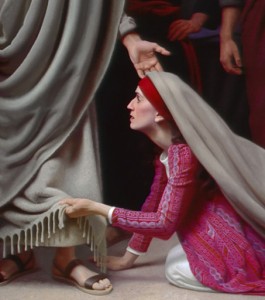Do you ever wonder why people were healed in the New Testament from touching Jesus’ garment? Matthew, Mark, and Luke all tell the story of a woman with a “discharge of blood” who “touched the fringe” of Jesus’ garment and was healed (Matthew 9:20-22; Mark 5:25-34; Luke 8:43-48). On another occasion, a crowd brought to Him “all who were sick and implored him that they might only touch the fringe of his garment.” The account ends with Matthew’s telling us, “As many as touched it were made well” (Matthew 14:34-36; cf. Mark 6:56).
 Some commentators gloss over these accounts, explaining them as God’s “accommodation” of the superstitious mindset of the age. Indeed, many fine scholars adopt this interpretation, and there is much to commend it. Still, in light of the Old Testament, there seems to be a better interpretation.
Some commentators gloss over these accounts, explaining them as God’s “accommodation” of the superstitious mindset of the age. Indeed, many fine scholars adopt this interpretation, and there is much to commend it. Still, in light of the Old Testament, there seems to be a better interpretation.
In the Mosaic Law, God instructed His people regarding the corners, or fringes, of their garments. Jews were to “make tassels on the corners of their garments throughout their generations, and to put a cord of blue on the tassel of each corner” as a reminder that they were God’s people called to keep His commandments (Numbers 15:37-41). It seems like a strange instruction until we learn that in the Ancient Near East, the corner of a person’s garment represented his identity; it was a symbol of who he was and what he stood for. That’s why Ruth, when she was seeking marriage to Boaz, asked him to spread the corner of his garment over her (Ruth 3:9). It was a request for him to identify with her. (The same Hebrew word means “wing” or “corner of a garment.” Thus, many translations render Ruth’s request as, “Spread your wings over your servant.” The double meaning here seems intentional.)
When God spoke of making a covenant with Israel, He pictured Himself as spreading the corner of His garment over her (Ezekiel 16:8)—a symbol of identifying with her as His bride. When David cut off a corner of King Saul’s robe, “afterward David’s heart struck him” (1 Samuel 24:5). These pangs of conscience seem strange unless we realize that he had defaced an important symbol of Saul’s identity and divinely authorized kingship.
So important were the corners of a Jewish man’s garment in ancient Israel that the Old Testament closes with a prophecy of the Messiah that references the corners of His garment: “But unto you that fear my name shall the Sun of righteousness arise with healing in his wings” (Malachi 4:2 KJV. Again, the same word means both “wings” and “corners of a garment”). At the heart of the Messiah’s identity would be healing—spiritual and eventually physical—for all who trusted Him.
The Jews in Jesus’ day were familiar with this Old Testament background. Indeed, the Pharisees wore elaborate tassels on the corners of their garments so that people would regard them as closely identified with God (Matthew 23:5). As a devout Jew, Jesus may well have worn tassels, though His would not have been elaborate showpieces like those of the Pharisees. When people reached for the corners of Jesus’ garment, it was in many cases more than a grab for the most accessible part of His person. It was a sign that they wanted to identify with Him.
There was nothing magical about the cloth that brought healing. It came by faith as people publicly aligned themselves with Jesus. As He told the woman with a discharge of blood, “Your faith has made you well” (Matthew 9:22). Perhaps Malachi 4:2 was even in her mind as she reached out and thought, “This is finally the one with healing in His wings.”
Though Gentile believers today don’t afford the same significance to garment corners, knowing this detail adds a layer of richness to the Gospels. And it calls us to imitate the faith of those who reached for Christ’s clothing—faith that He brings blessing and help to those who identify with Him as Lord and Savior.
I hope it’s OK to use this image. Please let me know if not. It’s not for commercial use, just a personal page about the Bible. if it is, my email address is Thandiwen@gmail.com so I can take it down. Thank you
Your comments were very interesting, and I’d like to add another bit of information to it. All of God’s commandments come to 613. Religious Jews wear what’s known as a tallit katan, or, a small tallit (prayer shawl). These are worn under the shirt and have four tassles, one on each corner, and with all the wraps, knots and fringes, they come to 613. Some Messianic Jews wear them today to show that they still identify with their heritage.